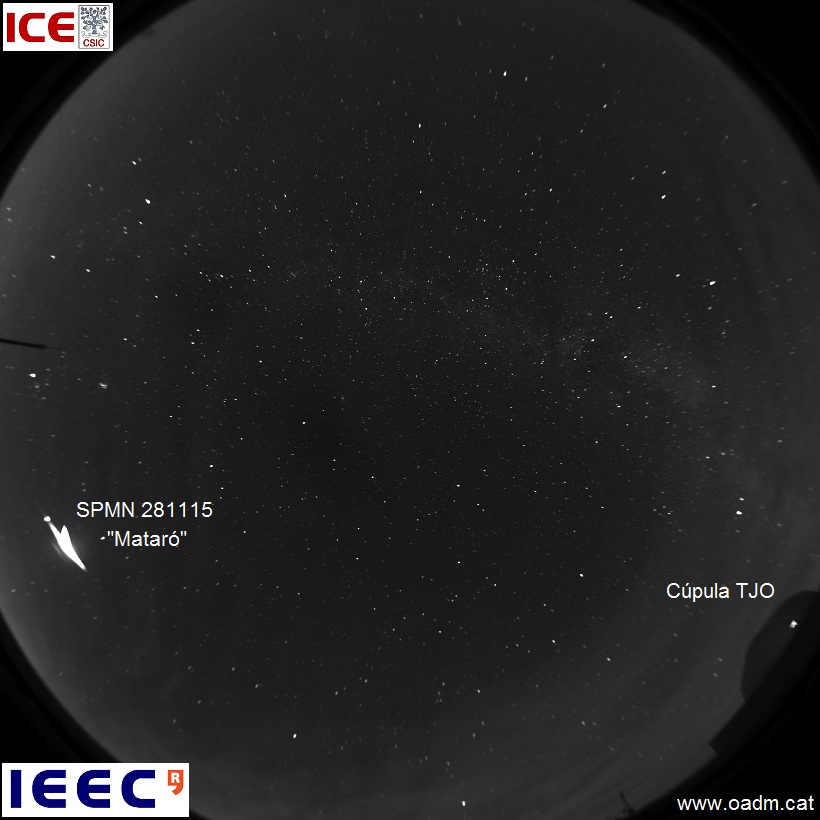The Observatori Astronòmic del Montsec of IEEC reconstructs the trajectory of the ‘great fireball Mataro’ last Saturday November 28 [NOT TRANSLATED]

– The speed of 54,000 km / h indicates that it came from the asteroid belt
– New images and videos
Last Saturday, November 28, at 20h07m08s local time, an interplanetary rock entered the atmosphere over the area of Barcelona and created a fireball much brighter than the moon which could be seen from much of the peninsula.
The phenomenon was recorded by the CCD all-sky of the Observatori Astronòmic del Montsec (IEEC) for other stations video-detection of the Spanish Meteor Network (SPMN) and some amateur astronomers. Now, analysis of these images had allowed to reconstruct the trajectory and orbit and determine some of its characteristics.
The fireball Mataro (SPMN281115) recorded by the CCD all-sky camera of the Observatori Astronòmic del Montsec (IEEC).
The great fireball Mataró (SPMN281115)
The rock was of a diameter not less than one meter and began producing light at a height of 100 km above the sea, off the coast of Maresme. A second later, the ball was fragmented. Josep Maria Trigo, principal investigator of the Group of Meteorites, Small Bodies and Planetary Sciences at Institute of Space Science (IEEC-CSIC) explains that “the first fragmentations occurred at high altitude, 80 and 70 km above sea level when it was flying over the town of Mataró.” The SPMN28115 fireball that scientists have dubbed ‘great fireball Mataró’, dropped to 60 km altitude before dying. Some of the material was deposited on the mesosphere as powder.
3D reconstruction of the atmosheric trajectory of the fireball Mataró. The red arrow represents the height trajectory. The black line is the projection of the trajectory above the Earth and passes over Mataro (M. Martínez-Jiménez / JM Trigo / IEEC-CSIC).
“The observations indicate that the meteoroid had a speed of 54,000 km / h, indicating that it came from the asteroid belt, and was composed of a very fragile material, possibly similar to carbonaceous chondrites (a type of meteorites rich on matter organic coming from primitive asteroids or comets, and that would be the first material around the Sun added 5.565 million years ago, from which terrestrial planets tens of millions of years later were formed). The issuance of this fine incandescent powder from the fireball generated a persistent trail for about ten seconds in the first part of the light path” according to Dr. Trigo. “The reconstruction of the trajectory allows us to state that meteorites wasn’t produced, as the fireball disintegrated at a high altitude.”
Observation of great importance
Register this fireball is very important to study the capacity of the atmosphere as a natural shield, obtain physical properties of rocks or determine its orbit. “Because of the difficulty of recording during the brief fireball stage, lasting only seconds, so far we only have been able to reconstruct the orbit of a about twenty meteorites” said Josep Maria Trigo.
The participation of amateur astronomers is essential in these observations. In fact, some of the most spectacular videos of this fireball from three video detection stations were operated by them: Pep Pujols, of the Agrupació Astronòmica d’Osona,Folgueroles; Josep M. Petit, of the Agrupació Astronòmica de Girona from Sant Antoni de Calonge; and Josep A. De los Reyes and Sensi Pastor from Observatorio Arroyo (Z78) in Cehegín (Murcia), at more than 500 km far away. Another amateur, Agusti Descarrega, got accidentally an astrophotography of the fireball from the mouth of Ebro River.
The fireball Mataro (SPMN281115) recorded by the video detecion station of the Institute of Space Sciences (IEEC-CSIC), Montseny, (JM Trigo / IEEC-CSIC)
Disintegration and fragmentation of Mataró bolide (SPMN281115) according to the registers made by Pep Pujols of the Agrupació Astronòmica d’Osona, from Folgueroles.
The fireball Mataró (SPMN281115) recorded by Joseph M. Petit, from the the Agrupació astronòmica de Girona from Sant Antoni de Calonge.
The OAdM all-sky camera
L’uptake from the Observatori Astronòmic del Montsec (OAdM) (OAdM) of IEEC was made possible by a digital camera that records all the sky which works every night of the year and is intended precisely detect meteors and other celestial phenomena unexpected. This camera comprises a CCD hypersensitive fisheye lens that allows you to monitor the night sky and detect meteor fireballs up of close to 700 km away, so that covers the entire northeastern Spain. The infrastructure is operated remotely from the Institute of Space Sciences (IEEC-CSIC), where it is “implementing a system for identifying fireballs that, coupled with instant online access to their images, can explain almost instantly nature these impressive celestial phenomena, “explains Josep Sanz, computer engineer at IEEC.
Observations of this camera are part of the Research Network Fireballs and Meteorites (SPMN), which for two decades scientifically explains the phenomena of light produced by the entry of rocks from far corners of the solar system and sometimes, the re-entry of space debris. The Institute of Space Sciences (IEEC-CSIC), in collaboration with other research groups, remains an updated list of the bolides that fly over the Iberian Peninsula.
L’Observatori Astronòmic del Montsec (OAdM)
L’Observatori Astronòmic del Montsec és una infraestructura científica gestionada per l’IEEC i es troba ubicat a 1.570 metres d’alçada a la serra del Montsec, 50 km al nord de la ciutat de Lleida i a tocar del municipi d’Àger, en ple Prepirineu català. Aquesta zona està reconeguda com una de les més indicades del continent europeu per a l’observació astronòmica gràcies a la combinació dels seus condicionants meteorològics i l’escassa afectació de la contaminació lumínica. És, sens dubte, un cel excepcional. A més de la càmera CCD de tot el cel, alberga també diversos telescopis i instrumentació científica. [NOT TRANSLATED]
